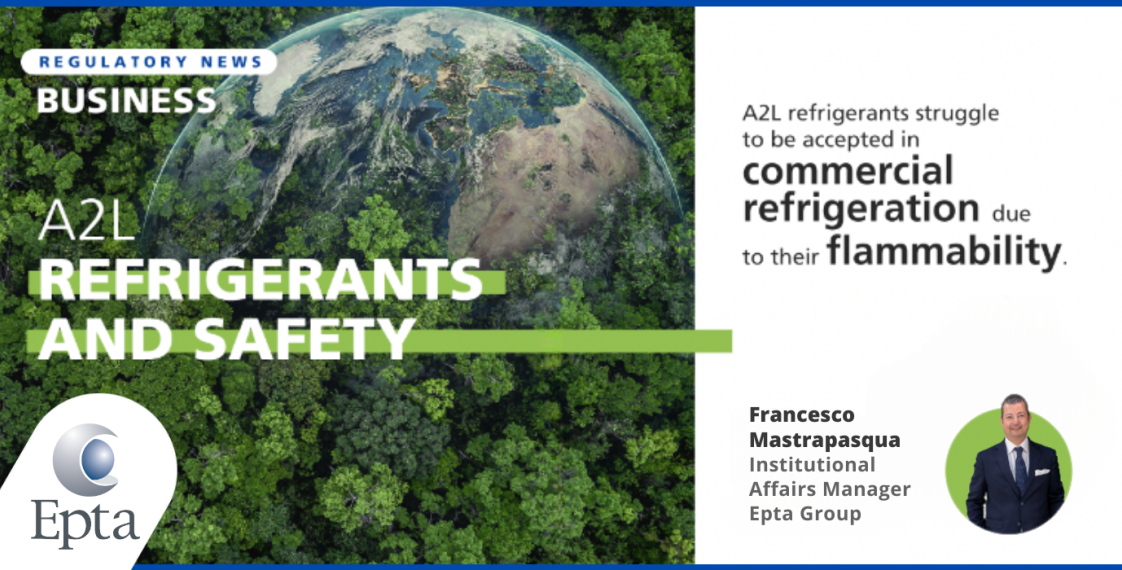SAFETY WITH A2L REFRIGERANTS

Risks associated with the use of refrigerants in refrigeration and air-conditioning equipment may include toxicity, flammability, asphyxiation and physical hazards. Although refrigerants can pose one or more of these risks, system design is key in mitigating them for the use of refrigerants in various types of equipment.
Each refrigerant gas, may it be fluorinated or a natural alternative, has its own chemical characteristics hence a different degree of toxicity and flammability, which are two fundamental variables for evaluating its safety when used for any kind of application.
Each gas is classified, both in terms of toxicity and flammability, based on the level of risk it can generate. According to ISO817, US ASHRAE 34 and EN378, the safety classification of refrigerants is defined through two alphanumeric symbols: a letter indicating the level of toxicity (A for low toxicity, B for toxic refrigerants) and a number indicating the degree of flammability (1 for non-flammable, 2L for low flammability, 2 for flammable, 3 for highly flammable refrigerants).
Profiling A2L Refrigerants: Low Toxicity vs. Flammability Challenges
A2L refrigerants are characterised by low toxicity and low flammability. Although the speed of flame propagation is low (less than 10 cm/s), this kind of refrigerants are considered dangerous for their capability to burn under certain conditions.
If on one hand low toxicity is a characteristic of the majority of the refrigerants adopted in refrigeration (with the remarkable exception of R717 ammonia which is definitely toxic), it is the flammability level of A2L refrigerants that determines their major limitations in the refrigeration sector.
As a matter of fact, in addition to having the desired thermodynamic properties, an ideal refrigerant would be nontoxic, nonflammable, completely stable inside a system, environmentally benign even with respect to decomposition products and abundantly available or easy to manufacture.
While it is pretty clear that A2L refrigerants do not meet the above positive factors, today the main factor preventing the penetration of A2L substances in refrigeration is its flammability, which largely compensates for them having a low GWP.
Refrigeration systems fuelled by flammable gases must comply with specific safety rules: primarily they need to comply with the EN378 standard and with all the national or regional fire security codes, as well as featuring a specific design that takes into account the risk of flammability. Besides, the installation site usually requires, for example, an adequate ventilation of the rooms in which they are installed in order to prevent the risk of fire in the event of refrigerant leakage.
In particular, the safety requirements of the EN378 indicate precise maximum refrigerant charge thresholds based on the concentration limits capable of propagating a flame under specified conditions and the space occupied. Furthermore, the EN378 standard establishes guidelines for safe handling in order to minimise the risks associated with a possible gas leak and concentration which could potentially allow the refrigerant to burn.
The maximum charge when using flammable refrigerants is obviously a severe limitation for system design, because it results directly into the upper limit cooling capacity that one can expect from each refrigeration circuit. As an example, in the case of R454C one can just use 57 kgs per circuit and therefore expect not more than 35 kW of cooling capacity at medium temperature which isn’t much for a food retail store!
Considerations for A2L Refrigerants in Appliances
The appliances (cabinets, freezers, power racks, …) must also be specifically designed for the use with an A2L refrigerant and the whole store design is to be certified by a third party to ensure that all the required precautions and fire prevention measures have been correctly applied.
From an economic perspective, A2L refrigerants are patented chemical products that link the end user to depend on them for the entire lifetime of the system, with prices and availability that may well vary over time depending on the market fluctuations and that will make the total cost of ownership very uncertain in the coming years, unlike natural refrigerants R290 propane and R744/CO2 which guarantee a low and stable price.
Beyond all this, there is another factor that poses a lot of uncertainty on A2L and fluorinated refrigerants in general: the PFAS issue. An issue which is gaining a lot of attention worldwide given that health-wise, the effects of a prolonged exposure to these substances, including intake from drinking water, becomes every day more evident.
The Future of A2L Refrigerants: Balancing Benefits and PFAS Concerns
Per- and polyfluoroalkyl substances (PFAS) are a group of approximately 10.000 man-made chemicals that are used in a variety of industries due to their sealing, temperature and pressure resistance and low friction properties. These “forever chemicals” are very persistent in the environment and in the human body – meaning they don’t break down and they can accumulate over time – originating a number of very serious health problems and diseases.
Most F-Gases, with few notable exceptions for R32, R152a, R23, R1132, are or degrade into PFAS as well as their potential breakdown product does namely TFA (Trifluoracid).
A potential incumbent threat for A2L refrigerants is the inclusion of these F-Gases in the REACH, which could potentially result in new prohibitions in the next 4-5 years thus shortening the expected lifetime of the equipment.
This being said, system providers and refrigeration companies are currently confronted with the responsability to inform end users on the possible long term consequences of their technical choices in a neutral and balanced way. Undoubtly A2L refrigerants are one viable low GWP alternative to traditional HFCs and are in compliance with the new F-Gas Regulation, however they also bring new uncertainties, mostly based on technical, economical and precautions that momentarily prevent their full market acceptance in refrigeration.
Only time will tell but in the meantime stay tuned!
READ NOW ALL ARTICLES ABOUT EPTA REGULATORY NEWS